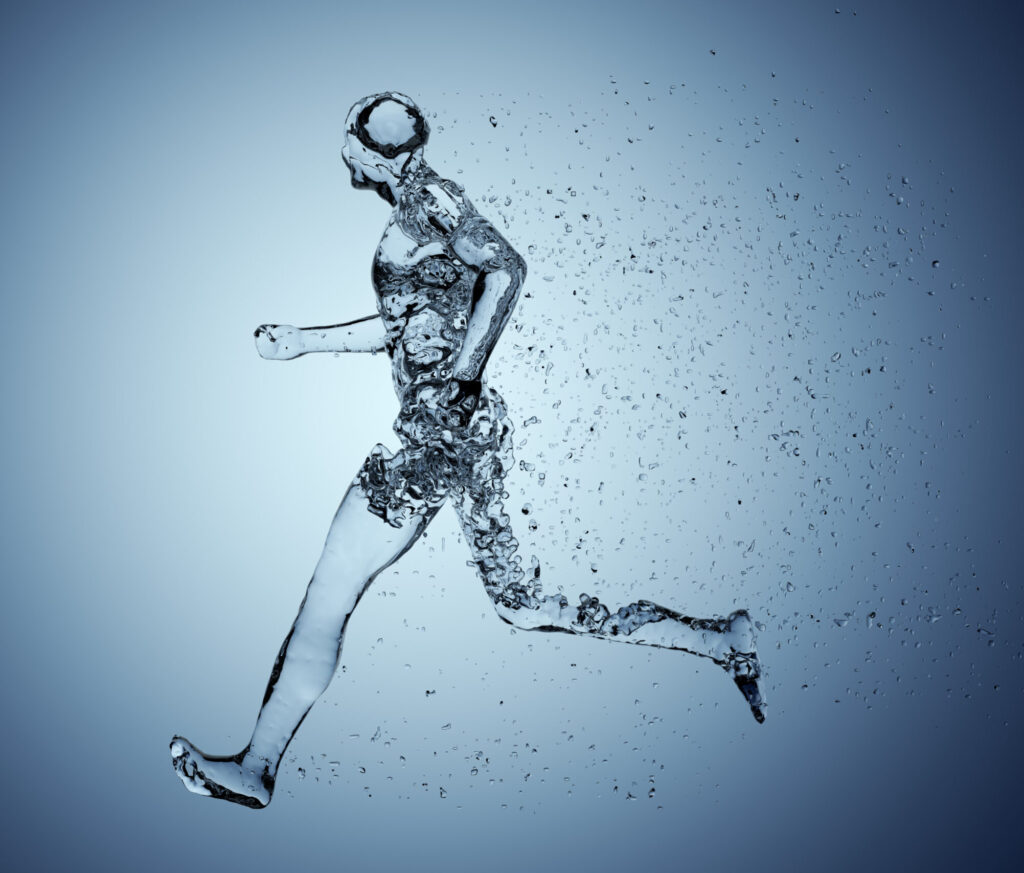
by Cora Maglaya, PT, ATC, CSCS | May 27, 2023
Serious gymnasts know how important it is to hydrate. Proper hydration helps improves muscle function, cools body temperature, and improves concentration. But happens when the perfect storm happens? Imagine it is a hot summer day. You drink coffee for breakfast, a high sugar electrolyte drink during practice and sugary drinks with dinner the night before. It is also 90F degrees at the gym with no air conditioning. By the time your body physically feels thirsty you are already dehydrated and you need to play catch up.
ABOUT HEAT EXHAUSTION AND HEAT STROKE
During dehydration, the body quickly loses fluids and electrolytes needed for muscle function. Dehydration in gymnasts on hot days can quickly escalate to heat exhaustion. This is when the body’s core temperature reaches 98.5°F to 104°F (37°C to 40°C). Common symptoms of heat exhaustion include nausea, headache, weakness, dizziness, a rapid heartbeat, vomiting, chills, and cramps. More serious cases of heat exhaustion can result in heat stroke. In heat stroke the body’s core temperature reaches 104°F to 112°F (40°C to 44°C). The symptoms that are distinctly different from heat exhaustion are unsteadiness with movement, poor muscle control, confusion and seizures. More serious measures of heat stroke treatment include hospitalization and body submerged ice baths.
To prevent dehydration during gymnastics training in the hot summer months, here are six tips that every gymnast should know:
1) EAT YOUR WATER
During your next grocery trip to the supermarket, buy fruits and vegetables. Foods such grapefruit, watermelon, cucumbers, strawberries, and lettuce, are all packed with high water content and have tons of nutrients. The water content will help with body temperature regulation, transport glucose, oxygen, and fat to your tired muscles, and help with digestion and waste product removal.

2) QUICK HYDRATION TEST
A quick test to do checking the color of your urine in the toilet. Urine color should be light or faint yellow if you are properly hydrating. Dark yellow is a bad sign and is a huge indicator of dehydration. Drink more fluids until the urine color becomes light yellow or is clear. Another testing option which is more advanced, is to weigh yourself both before and after the activity to calculate how much you are sweating. This is referred to as your sweat rate.

3) BE CRITICAL SELECTING SPORTS DRINKS
Popular sports drinks such as Gatorade, Propel and Powerade are electrolyte replacement drinks. When dehydration occurs, the body becomes deficient in minerals such as sodium, potassium, magnesium, and calcium. The sports drinks are looking to replace those lost minerals and help the digestive system absorb fluid and provide energy to your muscles. A potent electrolyte drink with minimal sugar is Pedialyte. This can be found in selected drugs stores. Pedialyte has a much higher potency than traditional sports drinks. When selecting sports drinks, choose ones that are sugar-free or low-sugar electrolyte drinks.
4) RAPID TREATMENT FOR DEHYDRATION
When a gymnast has any symptoms of feeling lethargic, faint, dizzy, and nauseous, they are already in trouble. These are signs of heat exhaustion and have the potential to escalate into a more serious condition called heat stroke. To cool the body temperature quickly at the gym, get a towel. (Use a t-shirt if you can not find a towel.) Dunk the towel in ice cold water, place some ice cubes in the middle, and roll the towel up like a burrito. Drape the towel with ice cubes around the neck. Place another towel soaked in ice water on the forehead. The towel on the neck sends messages rapidly to the brain that it does not need to go in emergency fight or flight mode and the body is safe. Loosen any tight clothing and get the gymnast in the coolest area in the gym quickly. In situations where the gymnast complains of feeling faint or is observed looking faint, lay the individual flat on their back and elevate their legs and feet on a higher surface.

5) POST-EXERCISE RECOVERY DRINK
After exercise, the body has been depleted of electrolytes and protein. The Nutrition Exercise and Health Sciences expert, Kelly Pritchett PhD, studied low fat chocolate milk as a post-exercise recovery beverage.
There is a 4:1 carbohydrate:protein ratio in chocolate mild which is excellent for fluid and sodium replenishment and providing both muscle recovery. Low fat chocolate milk distinctly differs from sports drinks in that it helps nourish muscle glycogen replenishment.

6) COCONUT WATER
Coconut water has unique benefits. Dehydrated gymnasts need mineral replenishment of sodium and potassium for muscle function and carbohydrates for exercise performance. Coconut water will not replenish carbohydrates and is low in both calories and sodium. However, it is packed with lots of healthy nutrients and is high in potassium. If you are dehydrated and are choosing between water alone and coconut water, coconut water is a better option for hydration. Be careful not to drink in high quantity as it has been known to be a laxative when consumed in large amounts.
The take home message is that you should be proactive rather than reactive when creating your hydration plan for optimal health. Use these tips to make sure you are properly cooling your body temperature and hydrating your body so you can feel energized, focused, and maximize your gymnastics performance.
Arca KN, Halker Singh RB. Dehydration and Headache. Curr Pain Headache Rep. 2021 Jul 15;25(8):56. doi: 10.1007/s11916-021-00966-z. PMID: 34268642; PMCID: PMC8280611.
Belval LN, et al. Practical Hydration Solutions for Sports. Nutrients. 2019 Jul 9;11(7):1550. doi: 10.3390/nu11071550. PMID: 31324008; PMCID: PMC6682880.
Barley OR, Chapman DW, Abbiss CR. Reviewing the current methods of assessing hydration in athletes. J Int Soc Sports Nutr. 2020 Oct 30;17(1):52. doi: 10.1186/s12970-020-00381-6. PMID: 33126891; PMCID: PMC7602338.